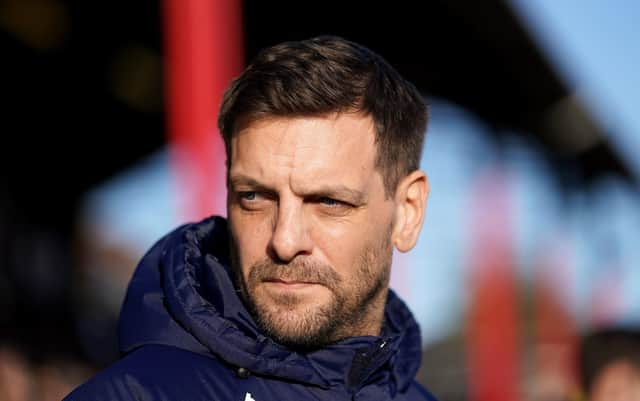The West Brom blueprint, wing-backs, two strikers: Jonathan Woodgate's Middlesbrough formation options assessed


The Teessiders are just two points above the bottom three with nine games left to play. Relegation to League One may be an unthinkable prospect, but remains a worrying possibility.
Woodgate therefore has some big decisions to make, not least what formation to deploy for the upcoming fixtures.
Advertisement
Hide AdAdvertisement
Hide AdOf course Boro’s system could change from match to match depending on the circumstances and opposition. The Teessiders’ set-up has altered on multiple occasions this campaign with varying degrees of success.
The high volume of games in a short space of time will also result in changes of personnel and squad rotation.
We take a closer look at Woodgate’s options ahead of next week’s Championship restart.
The West Brom blueprint
December’s excellent 2-0 win at West Brom wasn’t the first time Boro had played with this system, yet the side’s best performance of the season is worth further examination.
Advertisement
Hide AdAdvertisement
Hide AdLining up in a 4-2-3-1 formation, or 4-4-1-1 when they didn’t have the ball, Boro matched the hosts up from the start, nullifying the Baggies’ attacking threats.
George Saville and Adam Clayton helped protect the back four as West Brom dangerman Matheus Pereira was kept on the fringes with little space to operate in.
Boro were also a threat going forward as Lewis Wing enjoyed one of his best performances of the season in the No 10 role, providing support for lone striker Ashley Fletcher.
The pace of Djed Spence, deployed as a right winger, Marcus Tavernier and Hayden Coulson also caused the league leaders problems on the flanks.
Advertisement
Hide AdAdvertisement
Hide AdBefore the season was suspended, Woodgate reverted to a similar set-up in the matches against Leeds, Nottingham Forest and Charlton, following an alarming run of results and performances.
The side appeared better balanced in those games and it seemed Boro were beginning to turn a corner.
Wing-backs
Boro first started with a back three and wing-backs in September’s 1-0 defeat at Cardiff.
After initially trying to play with a 4-3-3 formation, Woodgate decided his team needed more security at the back, prompting a reintroduction of the wing-back roles following a chastening defeat at Birmingham.
Advertisement
Hide AdAdvertisement
Hide AdThe system gave Boro more stability until the Christmas period, while the emergence of Spence, as well as Coulson’s return from injury, gave the side some much-needed pace in wide areas.
There are different variations Boro could use if they do go with a back three, with their attacking options also a key factor.
At the start of 2020, the Teessiders were re-energised up front as Fletcher, Tavernier and new addition Patrick Roberts formed an effective pressing unit in a 3-4-3 system.
Roberts’ injury before the end of January broke up that promising combination, a setback Boro struggled to deal with.
Advertisement
Hide AdAdvertisement
Hide AdSince then, the use of a back three and wing-backs hasn’t brought the same success, and the Teessiders significantly underperformed against relegation rivals Luton and Barnsley.
Losing those two games plunged Boro right back into the relegation scrap and forced Woodgate to rethink his strategy.
Playing with two upfront
Now that everyone appears fit and available, it will be interesting to see how Woodgate utilises his attacking options.
As previously mentioned, Boro’s best performances this season have come when they have played with one striker – which has often been Fletcher, the club’s top scorer with ten goals this campaign.
Advertisement
Hide AdAdvertisement
Hide AdSo where does that leave fellow frontman Britt Assombalonga? The man who Woodgate labelled his first-choice No 9 back in August.
Assombalonga has missed a chunk of the campaign through injury and didn’t look fully fit when he briefly returned to action at the start of this year.
Boro’s record signing appears to be in better shape now though. Well, if the video clip of his goal in a friendly at Newcastle is anything to go by.
But while Assombalonga has registered better goal-scoring statistics throughout his career, he’s not as dynamic as Fletcher.
Advertisement
Hide AdAdvertisement
Hide AdThe pair could play together of course, and both Assombalonga and Fletcher have spoken highly about their relationship off the field.
Yet aside from an impressive 45 minutes against Hull, a game Boro were in control of until Marvin Jonhson’s red card, the striker combination hasn’t constantly clicked this season.
At least Woodgate has options, though, and the Boro boss has already said he’ll have to manage his squad through a congested run-in.
When it comes to attacking options, Rudy Gestede’s name can also be added to the conversation.
Advertisement
Hide AdAdvertisement
Hide AdThe towering frontman may have struggled to make a name for himself during his three and a half years at the Riverside, but was finding some form before the season was suspended.
Gestede was immense alongside Fletcher during a 2-0 win at Preston on New Year’s Day, despite not starting a single game in 2019.
It should also be remembered that Gestede was beginning to hit form when Boro needed him back in March, starting back-to-back games against Nottingham Forest and Charlton.
The 31-year-old may be out of contract this summer and is unlikely to be offered a new deal. For that reason, Gestede will be hoping to show what he’s capable of as his future hangs in the air.
